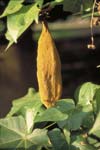Home >
Brachychiton discolor, Scrub Bottletree
Place in the full sun for best growth. Trunk is thickened at the base. Bark on young twigs and branches is bright green. Prune to develop and maintain a dominant leader and keep branches smaller than half the trunk diameter by regular pruning. Leaves and fruit bear small hairs that cause serious skin irritation.
Brachychiton is considered a poor compartmentalizer of decay. This means decay can develop and spread quickly following mechanical injury from construction activities near the tree, vandalism, storm damage, or improper pruning cuts.
Prune to maintain a dominant leader (one main trunk) by cutting back or removing competing leaders. Do this every 3 years for the first 15-20 years after planting. Do not allow branches with included bark to grow too large because they could split from the tree. This is best accomplished by removing some secondary branches (especially those toward the edge of the canopy) along those branches with included bark in the branch union. Regularly reduce the length of low aggressive branches by making reduction cuts if these branches will be in the way later and have to be removed. This will prevent having to make large pruning wounds later because the pruned branches will grow slower. Large pruning wounds can initiate decay in the trunk and branches, and decay can advance rapidly.





